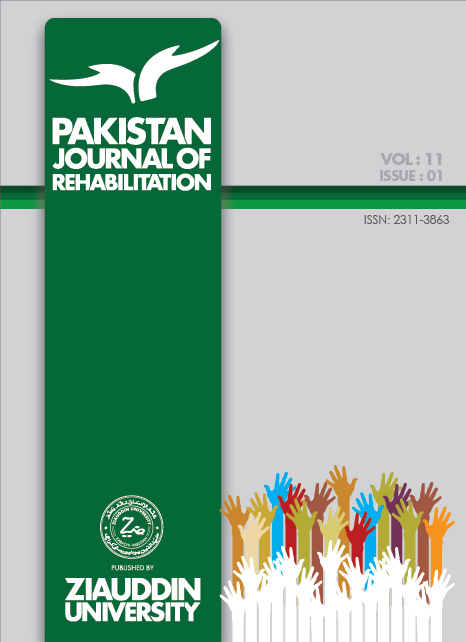Awareness of Gynecological Rehabilitation in Pregnancy, a Survey among Pregnant Patients in Gynae OPD Dow University Hospital, Karachi
Keywords:
Gynecological Rehabilitation; Pregnancy; Exercises; Pelvic floor; Urinary Incontinence; Primi – Gravida; Pregnancy RehabilitationAbstract
BACKGROUND
Pregnancy is the ideal time for positive lifestyle modifications, including consuming more healthy diet and increasing physical activity. Importance of exercise is supported by the increasing evidence for individual health but unfortunately women are not much aware about the benefits and importance of exercises.
OBJECTIVE
To evaluate how much the pregnant patients coming in gynecological OPD of DOW college clinic, Karachi know about gynecological rehabilitation in their pregnancy period. Moreover, the study will analyze the knowledge level of patients regarding rehab importance during pregnancy.
METHODS AND MATERIALS
A cross-sectional study design will be conducted to carry out the study. 158 participants were selected through convenient sampling technique from DOW university hospital, Karachi and the data will be collected by a self-structured questionnaire.
DATA ANALYSIS
SPSS version 22 will be used for the purpose of statistical analysis. Mean and standard deviation were calculated for all quantitative variables like age. Frequency and percentages were calculated for categorical variables like residence, educational status.
RESULTS
On the basis of gravida, patients of primi-gravida were 38(24.1%) and para-gravida 120(75.9%). 63.3% patients were unaware about physiotherapy services during pregnancy, 90.5% of patients didn’t know about kegal exercises, 56.3% of patients were unaware that weak pelvic floor muscles (PFMs) can cause urinary incontinence.
CONCLUSION
A majority of pregnant patients were participated and demonstrated in inadequate knowledge about gynecological rehabilitation in pregnancy. However, the patients who had awareness of gynecological rehabilitation were in minority. Information about the exercises during pregnancy considerably influences the approach towards exercises in pregnancy.
References
Hellwig K, Geissbuehler Y, Sabidó M, Popescu C, Adamo A, Klinger J, Ornoy A, Huppke P. Pregnancy outcomes in interferon-beta-exposed patients with multiple sclerosis: results from the European Interferon-beta Pregnancy Registry. Journal of neurology. 2020 Jun;267(6):1715-23.
Humphries A, Thompson JM, Stone P, Mirjalili SA. The effect of positioning on maternal anatomy and hemodynamics during late pregnancy. Clinical Anatomy. 2020 Sep;33(6):943-9.
Okafor UB, Ter Goon D. Physical activity and exercise during pregnancy in Africa: a review of the literature. BMC Pregnancy and Childbirth. 2020 Dec;20(1):1-7.
Phillips, C., Hillard, T., Salvatore, S., Toozs-Hobson, P. and Cardozo, L., 2020. Lasers in gynaecology. European Journal of Obstetrics & Gynecology and Reproductive Biology, 251, pp.146-155.
Saarikko J, Niela-Vilén H, Rahmani AM, Axelin A. Identifying target behaviors for weight management interventions for women who are overweight during pregnancy and the postpartum period: a qualitative study informed by the Behaviour Change Wheel. BMC pregnancy and childbirth. 2021 Dec;21(1):1-2.
Dilaxshan V, Nasmy MN, Sandamali AA, Sugandika RK, Waththage CN, Welgama WR, Senarath MK, Bandaranayake DW. Awareness and Effectiveness of Physiotherapy Interventions among Pregnant Women Attending Antenatal Care in Gangawatakoralle.
Duncombe D, Wertheim EH, Skouteris H, Paxton SJ, Kelly L. Factors related to exercise over the course of pregnancy including women's beliefs about the safety of exercise during pregnancy. Midwifery. 2009 Aug 1;25(4):430-8.
Gaston A, Cramp A, Prapavessis H. Enhancing self-efficacy and exercise readiness in pregnant women. Psychology of Sport and Exercise. 2012 Sep 1;13(5):550-7.
McDonald SM, Isler C, Haven K, Newton E, Kuehn D, Kelley G, Chasan‐Taber L, May LE. Moderate intensity aerobic exercise during pregnancy and 1‐month infant Morphometry. Birth Defects Research. 2021 Feb 1;113(3):238-47.
Schei B, Johannessen HH, Rydning A, Sultan A, Mørkved S. Anal incontinence after vaginal delivery or cesarean section. Acta obstetricia et gynecologica Scandinavica. 2019 Jan;98(1):51-60.
Whitford HM, Alder B, Jones M. A cross-sectional study of knowledge and practice of pelvic floor exercises during pregnancy and associated symptoms of stress urinary incontinence in North-East Scotland. Midwifery. 2007;23(2):204-17.
Lasserre A, Pelat C, Gueroult V, Hanslik T, Chartier-Kastler E, Blanchon T, Ciofu C, Montefiore ED, Alvarez FP, Bloch J. Urinary incontinence in French women: prevalence, risk factors, and impact on quality of life. European urology. 2009 Jul 1;56(1):177-83.
Memon H, Handa VL. Pelvic floor disorders following vaginal or cesarean delivery. Current opinion in obstetrics & gynecology. 2012 Oct;24(5):349.
Hill A-M, McPhail SM, Wilson JM, Berlach RG. Pregnant women’s awareness, knowledge and beliefs about pelvic floor muscles: a cross-sectional survey. International urogynecology journal. 2017;28(10):1557-65.
Sajan M. Awareness of physiotherapy interventions among pregnant females in antenatal clinics, Buffalo city municipality, Eastern Cape, South Africa. 2013.
McMillan AG, May LE, Gaines GG, Isler C, Kuehn D. Effects of Aerobic Exercise during Pregnancy on One-Month Infant Neuromotor Skills. Medicine and science in sports and exercise. 2019 Jun 13;51(8):1671-6..
Barakat R. An exercise program throughout pregnancy: Barakat model. Birth Defects Research. 2021 Feb 1;113(3):218-26..
Afroz F. Pregnant women’s awareness about physiotherapy services at selected maternity hospital: Bangladesh Health Professions Institute, Faculty of Medicine, the University of Dhaka, Bangladesh); 2015.
Maly B. Rehabilitation principles in the care of gynecologic and obstetric patients. Archives of physical medicine and rehabilitation. 1980;61(2):78-81.
Bayat, M., Eshraghi, N., Naeiji, Z. and Fathi, M., 2021. Evaluation of Awareness, Adherence, and Barriers of Pelvic Floor Muscle Training in Pregnant Women: A Cross-sectional Study. Female pelvic medicine & reconstructive surgery, 27(1), pp.e122-e126.
Ali, S.H., Rizvi, S.A.S. and Naqvi, M., 2013. Physical activity level in medical students of the Ziauddin University, Karachi. Pakistan Journal of Rehabilitation, 2(1), pp.31-34.
Watson ED, Oddie B, Constantinou D. Exercise during pregnancy: knowledge and beliefs of medical practitioners in South Africa: a survey study. BMC pregnancy and childbirth. 2015;15(1):245
Sultan F, Hasan Z. PARENTAL PERCEPTION ABOUT WESTERN CARTOON ON CHILD’S MENTAL HEALTH IN PAKISTAN. Pakistan Journal of Rehabilitation. 2020;9(2):48-53.
McMillan AG, May LE, Gaines GG, Isler C, Kuehn D. Effects of Aerobic Exercise during Pregnancy on One-Month Infant Neuromotor Skills. Medicine and science in sports and exercise. 2019 Jun 13;51(8):1671-6.

Published
How to Cite
Issue
Section
License
Copyright (c) 2022 Pakistan Journal of Rehabilitation

This work is licensed under a Creative Commons Attribution 4.0 International License.



